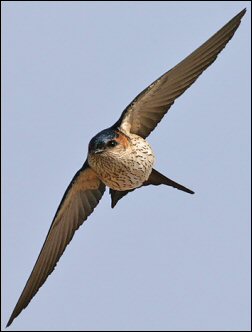Hebei Province

Birding Hebei
Hebei is a northern province of the People’s Republic of China. The name Hebei means ‘north of the (Yellow) River’.Zhili meaning ‘Directly Ruled (by the Imperial Court)’, was the name of Hebei before 1928.Hebei completely surrounds Beijing and Tianjin municipalities (which also border each other). It borders Liaoning to the northeast, Inner Mongolia to the north, Shanxi to the west, Henan to the south, and Shandong to the southeast. Bohai Bay of the Yellow Sea is to the east. A small part of Hebei, an exclave disjointed from the rest of the province, is wedged between the municipalities of Beijing and Tianjin. The provincial capital of Hebei is Shijiazhuang.Most of central and southern Hebei lies within the North China Plain. The western part of Hebei rises into the Taihang Mountains (Taihang Shan), while the Yan Mountains (Yan Shan) run through northern Hebei, beyond which lie the grasslands of Inner Mongolia. The Great Wall of China cuts through northern Hebei from east to west as well, briefly entering the border of Beijing Municipality, and terminates at the seacoast of Shanhaiguan in northeastern Hebei. The highest peak is Mount Xiaowutai in northwestern Hebei, with an altitude of 2882 m.Hebei borders Bohai Sea on the east. The Hai He watershed covers most of the province’s central and southern parts, and the Luan He watershed covers the northeast. Not counting the numerous reservoirs to be found in Hebei’s hills and mountains, the largest lake in Hebei is Baiyangdian, located mostly in Anxin County.Hebei has a continental monsoon climate, with temperatures of -16 to -3 °C in January and 20 – 27 °C in July, and with annual precipitation of 400 to 800 mm, occurring mostly in summer.
-
Beidaihe [Happy Island]
Satellite View4 hours from Beijing, legendary coastal migration spots, with peak time being first three weeks of May, then a protracted Autumn migration beginning in late June with reverse shorebird migration, peak passerine diversity in late September, and Crane migration from mid October through to early November. Expectations: 150-200 for experienced birders in a three-week peak-time trip.
-
Wikipedia
GNU Free Documentation License
http://en.wikipedia.org/wiki/Hebei
-
Number of bird species: 539
(As at August 2018)
- But there are seven 'breeding endemics': Chinese Crested Tern Thalasseus bernsteini, Swinhoe's Minivet Pericrocotus cantonensis, Baikal Bush Warbler Locustella davidi, Manchurian Reed Warbler Acrocephalus tangorum, Buff-throated Warbler Phylloscopus subaffinis, Sulphur-breasted Leaf Warbler Seicercus ricketti & Red-billed Starling Spodiopsar sericeus
-
Guide to the Birds of China
See Main China Page For Details ISBN: 9780192893673 Buy this book from NHBS.com
-
Xipobo Bird Watching Society
InformationXipobo Bird Watching Society (Xipobo BWS) established in 1999 at Hebei Province during a "Love Bird Week" activity at Ping Shan County. In April 2002, it was formally registered at the Civil Affairs Bureau as an organization for non-profit purpose. Xipobo BWS aims to promote wildlife and environmental conservation in Ping Shan County, it also assist taking care of injured animal and promote bird watching activities. Target audiences are the general public in particular student. The Society also facilitate them to understand the importance of protection of wildlife and their environment, and the "Law of the Protection of Wildlife"
-
Shennongjia Forestry District
InformationSatellite ViewShennongjia Forestry District is named after the Shennongjia mountainous massif, which is usually considered to be the eastern (and the highest) section of the Daba Mountains (Daba Shan)
-
2013 [05 May] - Bill Blake & Vaughan Ashby - Beidaihe
PDF Report…Kentish Plovers, a couple of Greater Sandplovers, Red Knots, Sanderlings, Red-necked Stints, a single Sharp-tailed Sandpiper, Curlew Sandpipers, Bar–tailed Godwits, Whimbrels, Common Redshanks, Common Greenshanks, Wood and Terek Sandpipers were all seen…. -
2015 [05 May] - Vaughan & Svetlana Ashby - Beidaihe
PDF Report -
2016 [10 October] - Rich Lindie
PDF Report...Of those that we did see well, a Little Bunting, Chinese Penduline Tit and Black-browed Warbler were highlights, making our afternoon stroll around the northern end of the island a worthwhile excursion... -
2017 [05 May] - Martin Tribe - Beidaihe and Happy Island
Report...After around an hour’s sightseeing we managed to see some birds: Eurasian Magpie, Large-billed Crow, Spotted Dove, Eurasian Tree Sparrows and lots of Common Swift, Barn and Red-rumped Swallows. These species were seen in most low-level areas with the amount of Eurasian Tree Sparrows seen being quite amazing. A short ride to Yuyuantan Park to catch up with more of the “local” birds namely Black-crowned Night-heron, Mandarin Duck (real ones) Mallard, Common Kingfisher, Great Spotted Woodpecker, Light-vented Bulbul, Chinese Blackbird, Pallas’s Leaf Warbler, Yellow-browed Warbler, Taiga Flycatcher, Japanese Tit, Azure-winged Magpie, White-cheeked Starling, Crested Myna and Yellow-billed (Chinese) Grosbeak... -
2017 [05 May] - Vaughan Ashby - Beidaihe
PDF Report...The main reason for visiting was the waders t hat incl uded Little Ringed and Kentish Plover s and Greater and Lesser Sandplovers, Ruff, Pacific Golden -plover, B lack -bellied (Grey) Plover, Grey -headed Lapwing, Great Knot, Red-necked Stint, Temminck ’s Stint, Sharp -t ailed Sandpiper, Curlew and Broad -billed Sandpipers, Bar -t ailed Godwit, Whimbrel, Eurasian Curlew, Spotted Redshank, Common Redshank, Common Greenshank, Terek Sandpiper and Ruddy Turnstone... -
2017 [06 June] - Terry Townshend
Report...The spectacular concentrations of shorebirds, not to mention the world-class visible migration of passerines, makes it one of the best birding sites within easy reach of the capital...
-
Birds at Beidaihe
WebsiteI first visited Beidaihe, a resort on China's east coast, in spring 1985, and have returned each year since, mostly as leader or co-leader of migration surveys and birding tours, a couple of times for a holiday. In all, I have spent over a year at the town, garnering a Beidaihe list with over 300 Asian migrants, and experiencing superb spells of birding. In addition, trying to stimulate conservation work


